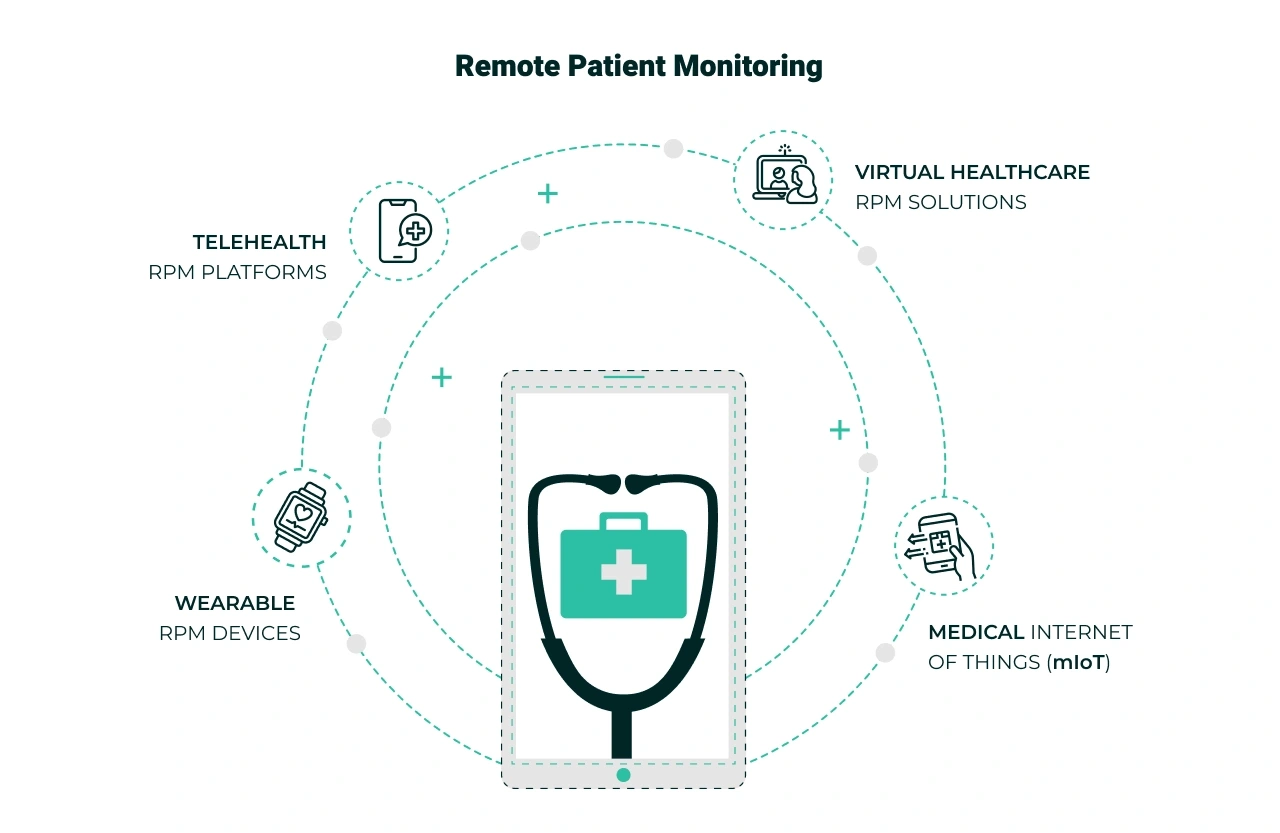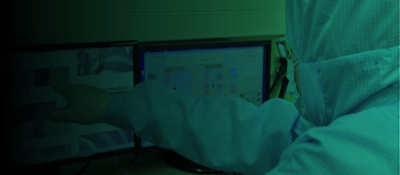How Remote Patient Monitoring can Improve Healthcare Access
Key Highlights
Remote patient monitoring (RPM) is the use of medical devices, healthcare practice management software, hardware integrations, and new categories such as wearables and smart homes hooked into the medical internet of things (MIOT).
RPM builds quicker feedback loops between patients and providers, reducing the need for time-consuming and expensive emergency services.
As remote patient monitoring tool usage increases, the cost of care drops, and patients receive more efficient and timely medical services.
Is your organization on the right track when it comes to your investment to advance RPM capabilities? Are your executive decision makers discussing the top remote patient monitoring use cases? Keep reading to learn more about why this fast moving trend is transforming distance-based medicine.
Remote patient monitoring systems (RPMS) is the use of medical devices, healthcare practice management software, hardware integrations, and new categories such as wearables and smart homes hooked into virtual care solutions through the medical internet of things (mIOT).
Definitive Healthcare reports that between 2019 and 2022 remote patient monitoring related insurance claims increased by 1,300%.
They found conclusive data from payers, electronic health record software vendors, and hospital operations analytics data showing the rapid growth of this innovative new medical practice approach.
The largest increases were seen across internal medicine specialists whose usage of RPM increased by 30% in the last three years.
Virtual care solutions, telehealth and RPM act as vital touchpoints linking patients and providers for remote digital health services.
Remote patient monitoring tools act as vital touchpoints linking patients and providers across an increasingly distributed remote community health network. As healthcare organizations build an end-to-end digital health ecosystem, custom RPM solutions act as bridge points connecting patients in rural and underserved communities to more robust home-based treatment options to improve preventative medicine.
RPM adoption and implementation is steadily increasing because providers see the value in the cost-savings it drives. These tools are often paired with complimentary digital health services such as virtual care, telemedicine, telehealth, and patient portals to create better feedback loops to improve patient medical health outcomes.
In this article learn more about how remote patient monitoring works for healthcare and the most important RPM use cases shaping practice in healthcare.
RPM drives smart automation and the optimization of clinical work flows to improve accuracy and drive better medical outcomes.
How Remote Patient Monitoring is Improving Healthcare Access and Convenience
Remote patient monitoring connects patients with their providers through remote sensors, wearables, medical devices, medical software, and other technologies. The main benefit of RPM for healthcare providers is the increased access and convenience it affords patients and providers.
RPM builds quicker feedback loops between patients and providers, reducing the need for time-consuming and expensive emergency services. Patients who engage with RPM tools are more likely to follow medical guidelines leading to better outcomes. RPM saves lives, reduces costs, and drives more efficient distance-based medical care.
The RPM Systems Market is worth $745.7 million in 2022 but is projected to increase by 128% to $1.7 billion by 2027.
Uses of Remote Patient Monitoring in Healthcare
RPM software and hardware solutions are being rapidly adopted across healthcare and clinical medical practice settings.
“Heart disease, diabetes, and chronic lung disease are among the most prevalent and deadliest chronic illnesses in the U.S. It’s unsurprising then that specialists who see larger volumes of chronically ill patients with relatively intensive disease management needs are also the top users of RPM,” says data analytics firm Definitive Healthcare’s report.
They found that between January 2019 and November 2022, the remote patient monitoring claim volume increased by 1,294%. RPM is a valuable tool that extends the reach of healthcare organizations providing the agility to improve medical outcomes dramatically.
“Generally, cloud computing is integrated with wireless sensor networks to enable the remote monitoring systems, improving the quality of service. The sensed patient data are monitored with biosensors without considering the patient data type, and this minimizes the work of hospitals and physicians.
Wearable sensor devices and the Internet of Medical Things (IoMT) have changed health services, resulting in faster monitoring, prediction, diagnosis, and treatment. Nevertheless, difficulties need to be resolved using AI methods.” writes Ahia et al.
One of the main reasons it makes sense to adopt and implement advanced RPM capabilities is to protect your organization against an uncertain economic future. Digital transformation is the way to strengthen your position against a rapidly evolving and more competitive healthcare business environment.
The winners of tomorrow will be the healthcare enterprises that complete strategic investments to increase resources and expertise in critical areas of advancement, such as digital health, telehealth, automation, and the interoperability of personal health information across the community health matrix.
Remote patient monitoring wearables, virtual health, and the medical Internet of Things (IoT) seamlessly link patients to their healthcare services. Here are some of the most compelling use cases for remote patient monitoring solutions.
RPM Use Cases in Healthcare

“With a rise in the number of digital touchpoints with which a patient interacts, the possibility of forecasting whether sickness may become a severe problem for a patient in the future grows. The massive volume of data from medical gadgets helps profile patients and better understand their anatomy.
The push to preserve electronic health information has made and will continue to simplify predictive health analysis. Real-time technology can assess the need for medicines, equipment, and other healthcare requirements.
Mobile technology will enable physicians and specialists to communicate remotely, staying in touch regardless of location. Various healthcare software solutions are being created to increase patient happiness and expedite communication between hospitals and patients,” researchers Haleem et al. wrote in a paper titled Medical 4.0 Technologies for Healthcare: Features, capabilities, and Applications in the peer-reviewed journal Internet of Things and Cyber-Physical Systems.
Wearables and other patient-facing remote monitoring technologies form the first layer of digital health 2.0: seamlessly linking medical professionals with their patients across a distributed medical internet of things.
Wearable Remote Patient Monitoring Devices:
Blood Pressure Sensor: Bluetooth blood pressure sensors relay clinical data about the patient’s blood pressure in real time.
Clinical Observation Tools: Monitoring solutions allow clinicians to observe patient behaviors to provide more reliable therapeutic guidance and medical decision-making.
Glucometer: More than 11% of the U.S. population is diabetic, with a new diagnosis every 17 seconds—glucometers are vital in monitoring patients with Type 1 and Type 2 diabetes.
Pulse Oximeter: Many new wearables, such as smartwatches, activity monitors, and mobile phones, contain software that monitors oxygen levels.
Hospital-At-Home: Smart homes of the future will be outfitted with a wide range of diagnostic tools, bridging the gap between patient and provider through remote clinical services.
ECG + Stethoscope: Digital stethoscope tools provide reliable real-time monitoring of the patient’s heart activity.
Activity Trackers: Wearable tools to monitor step counts, stairs climbed, and other health and wellness targets.
Digital Wellness Devices: Many devices and applications provide remote mental health and wellness check-up opportunities for patients wishing to access these services on an on-demand, as-needed basis.
Thermometer: Simple solutions monitor vital signs such as temperature providing real-time data connections between patients and providers on the medical Internet of things.
Scales: Mobile phone apps and other wearable medical devices monitor patient activity levels and weight fluctuations.
Virtual Care Remote Patient Monitoring Solutions
Telehealth and virtual healthcare services form the next layer of the digital health network linking patients and providers using digital communications technologies. Virtual solutions empower patients to participate more actively in their care plans.
Telehealth platforms, digital health applications, and other custom remote patient monitoring solutions extend the reach of healthcare organizations to provide 24/7 digital health services.
Since its inception in the early 2000s, the telemedicine market was valued at $83.5 billion in 2022—though it is projected to exceed $101.2 billion in 2023—and top out at more than $455.3 billion by 2030.
Virtual Care Remote Patient Monitoring Use Cases
Guide Patients on Seamless Holistic Health and Wellness Journeys: Virtual health care solutions provide patients with the health insights they need to make informed decisions about their health and wellness to promote vitality and longevity.
Manage Acute Conditions Remotely: RPM and telehealth solutions allow clinical teams to track vital signs and biomarkers between in-patient care visits.
Stabilize Critical Patients at Home: Telehealth and remote patient monitoring tools allow clinical care teams to monitor their patients’ recoveries remotely from their homes.
Build a More Cohesive Regional Care Network: Telehealth solutions link rural and homebound patients to vital life-saving services in their communities.
Strengthen Competitive Advantage: Strengthen your organization’s reputation by delivering world-class digital health experiences linked with virtual care opportunities and remote patient monitoring tools.
Medical Internet of Things Remote Patient Monitoring Use Cases
The mIOT is the final layer that links patients and providers across the digital health ecosystem. Cloud-powered services need lightning-fast to empower faster data exchanges while maintaining rugged security to protect that personal health information.
The medical Internet of Things offers the distributed network effect linking a patient’s smart home outfitted with a wide range of medical devices designed to provide real-time updates of their vital signs to their doctor, who monitors from the other side of the state.
Here are some essential remote patient monitoring use cases for the medical internet of things:
Spirometers
Blood Pressure Cuff
ECG and Digital Stethoscope
Glucometer
Weight Monitors
Pulse Oximeter
The IoT provides the foundation linking all the digital health services and medical devices patients use to manage their care remotely. The IoT connects patients and providers across distributed medical devices, mobile and web applications, and cloud-powered solutions.
The result is a seamless digital health ecosystem providing around-the-clock services and 24/7 monitoring to ensure patients are as healthy and vibrant as possible.
Benefits of Remote Patient Monitoring (RPM) in the Healthcare Industry
Robotic process automation is one major component of RPM best practices that reduces the need for slow and time-consuming manual processes. RPM solutions round out digital health services and act as the perfect complement to telehealth platforms, patient portals, and other leading patient engagement tools.
Here are some of the main benefits of RPM adoption.
Embrace the Future of Data-Driven Value-Based Care
RPM positions your organization to improve clinical efficiencies at scale to enhance and streamline your in-patient and outpatient efficiency, ultimately leading to not only cost savings but increased profitability.
Transform Practice Environments through More Robust Digital Transformation
Your patients already crave more convenient and seamless services. RPM gives the people what they want: access to on-demand treatment options and the ability to improve the connectivity of home-based treatment options so providers monitor real-time data to improve decision-making.
Build More Personalized and Profitable Patient Journeys
Patient engagement is essential for reducing the cost of care and building more sustainable and profitable therapeutic alliances. Patients crave a degree of freedom in service planning enhanced tremendously by RPM.
Extend the Reach of Your Clinical Medical Teams
Cut through slow and time-consuming administrative tasks with more business process automation, real-time data analysis, and streamlined workflows to empower your best to focus attention on what matters. Deliver a more efficient and value-driven workforce.
Catalyze Digital Acceleration to Fuel Success in the Future
Remote patient monitoring adoption rapidly transforms how community health networks serve patients. Invest in your organization’s health informatics future.
Why is Remote Patient Monitoring essential to delivering more seamless Patient Engagement?
Healthcare has not traditionally been quick to change or adopt new technologies. The new normal of the pandemic made digital transformation a priority, and now it’s impossible to turn back the market-wide disruption driven by RPM-powered medical innovations.
RPM is a touchpoint to drive more effective feedback loops between patients and their providers. As remote patient monitoring tool usage increases, the cost of care drops, and patients receive more efficient and timely medical services.
Your organization can harness its potential by investing in custom software solutions to fuel remote patient monitoring and other critical fundamentals of virtual care services. Automate your services, move to the cloud, and embrace tomorrow’s hybrid remote organizational culture.
RPM is the way forward. Our team can help you move in the right direction. We supply healthcare IT consulting, digital product design, and healthcare software development services your organization needs to conquer tomorrow’s health informatics health challenges.
How Asahi Technologies can help you develop Remote Patient Monitoring Software
Asahi Technologies is an agile distributed full-stack software development specialist serving healthcare, medical, and pharmaceutical enterprises.
We supply cost-effective custom software, healthcare IT, cybersecurity, and DevOps support to help your teams thrive. Capture the value of a fractional Healthcare IT partner when you need it. Our team augmentation services fuel your next stage of growth.
Overcome complex technical challenges with the on-demand talent needed to succeed. Get in touch today to learn more about our remote patient monitoring solutions.
Like this project
Posted Sep 6, 2023
Learn how remote patient monitoring can help bridge the gap in healthcare access and provide greater convenience for patients.
Likes
0
Views
13




